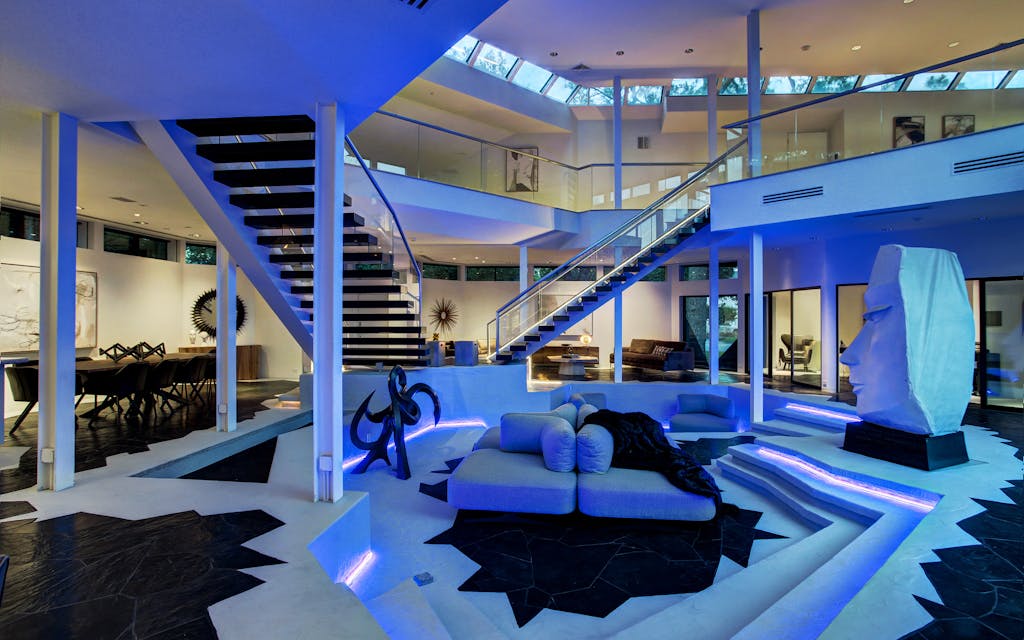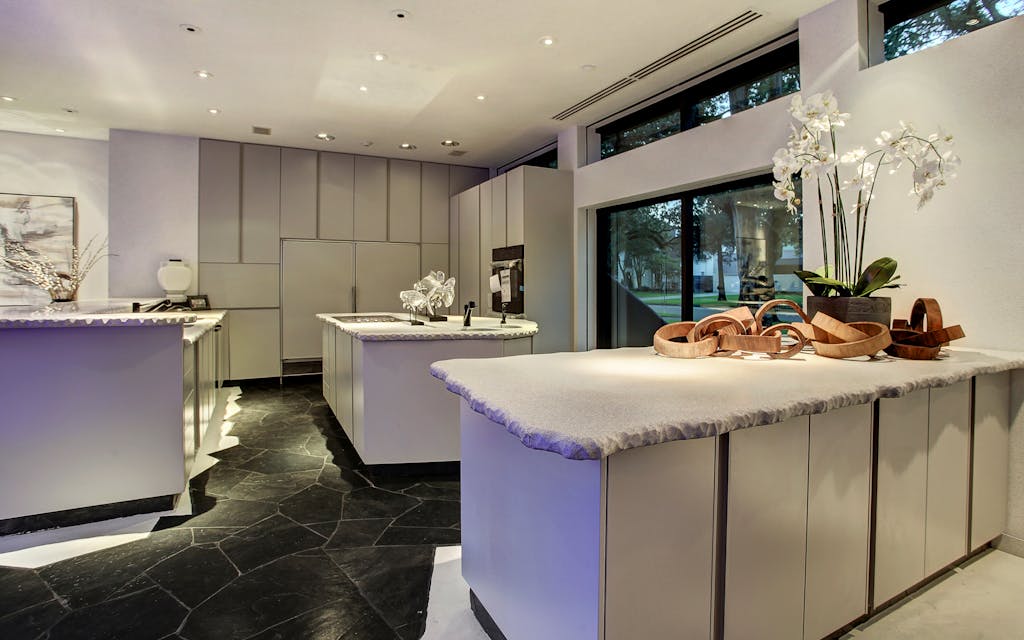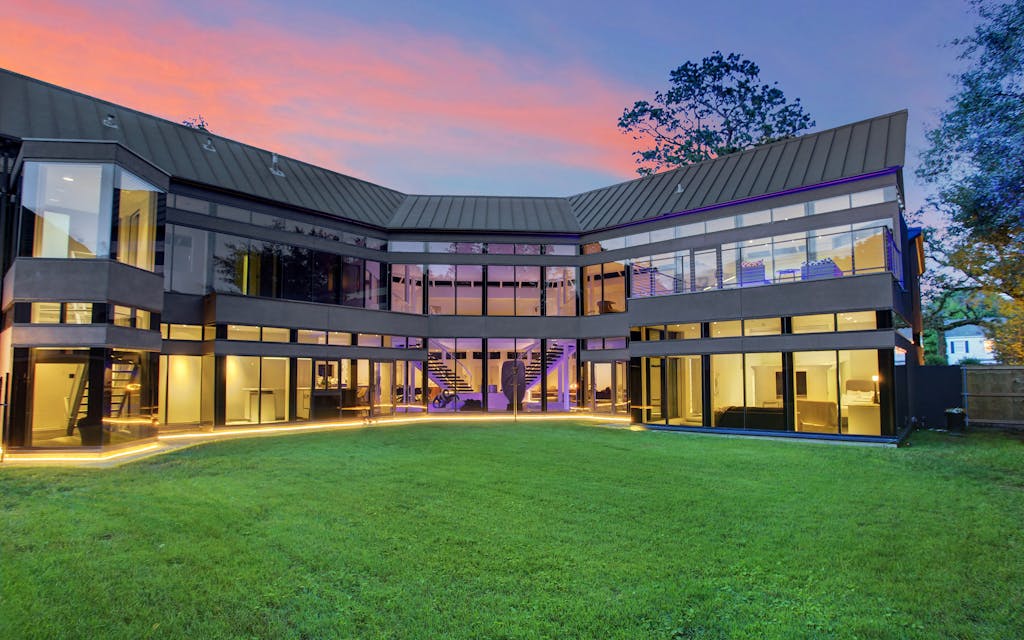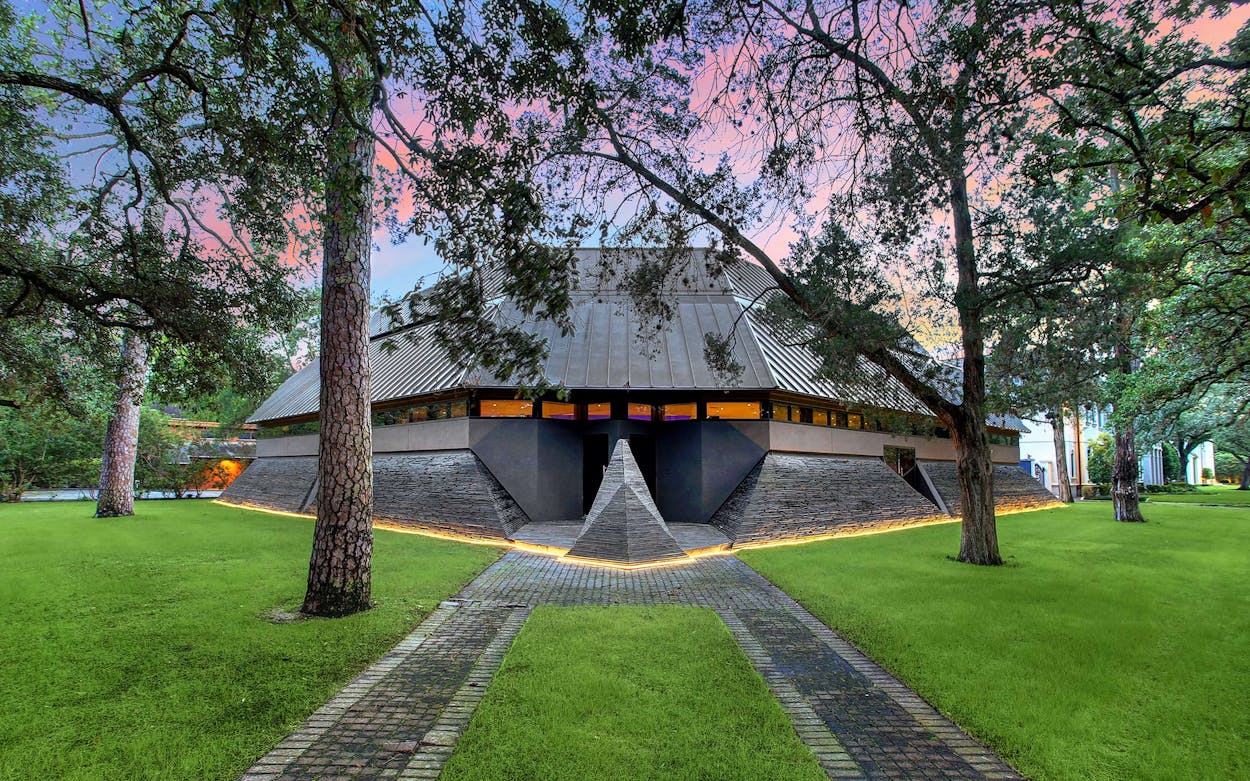As I walk up to the imposing octagonal house, I can’t believe I’m actually here. I peer unsuccessfully through the tinted windows, waiting for someone to let me in one of the two identical black doors. I feel as if I’m lining up for a rave at an experiential Berlin club, waiting for a benevolent bouncer to let me into the party. But it’s lunchtime, and I’m standing on a verdant Houston street not far from where I grew up, dwarfed by this mammoth, stucco-metal structure. It looks like a UFO that somehow blitzed through a wormhole, crash-landed on a picturesque corner, and sandwiched itself in between the cheery brick homes. As I wait outside by the ring of live oak trees on the 18,000-square-foot lot, I get the sense I’m being watched. I whip around to face the street, where a parade of cars are pausing for passengers to snap quick photos of the edifice before driving away.
I understand the curiosity. Since its construction in 1992, this idiosyncratic West University Place home—dubbed the Darth Vader House for its uncanny resemblance to the Star Wars villain’s headgear—has both fascinated and baffled Houstonians, myself included. Because its owner, a plastic surgeon named Jean Cukier, has long refused interviews and interior photos or tours of the house, rumors have abounded about what lay inside this dark fortress. That’s why the home’s $4.3 million listing, which appeared last week, complete with a photo gallery, garnered headlines worldwide, in outlets from CNN to Fortune Greece. News sites were awed by the peculiar exterior of 3201 University Boulevard and, even more, by what the 7,000-square-foot home looked like inside (verdict: it’s both “bizarre” and a “contemporary masterpiece”). When the news broke—and yes, this was big news!—I arranged a tour with the Sotheby’s listing agents. I wanted to see it for myself.
So after years spent wondering what might be inside (as a kid, I imagined that it was actually separate split-level homes for two families that led completely different lives), I am standing on Darth Vader’s doorstep on a balmy Sunday afternoon. Then, just after one o’clock, Nadia Carron, one of the home’s realtors, bursts open a door (the one on the right) and ushers me inside. To my surprise, I see Cukier. I say hello, and he stands there silently before quickly shuffling away.

The home opens up to a dramatic sunken living room, with steps descending into a depressed seating area—a popular midcentury architectural flourish known as a “conversation pit”—surrounded by grand twin staircases ascending to the second level. One of the architects who worked on the home, Randy Hickey, later tells me over the phone that the living area was meant to emulate a canyon, which explains the jagged steps and craggy openings. At one point a flat-screen television was meant to rise out of one side of the floor, he adds, but it never came to fruition.
Carron’s team added bright blue LED strip lights to the flooring to accentuate the property’s unusual features; they amplify the feeling of being on the set of a retro space-age B movie, à la Barbarella. I can’t get over the soaring ceilings, given that the home appears almost squat from the outside, or the fact that the house isn’t bathed in darkness, something I had long assumed. Instead, floor-to-ceiling windows make up a lofty back wall, spilling light onto the living area.
The owner never intended for his home to become a living testament to Darth Vader’s helmet, Carron tells me. Cukier’s initial vision involved creating something “dark and mysterious” that was inspired by a stealth fighter aircraft. “He was into the F-111 stealth fighter,” explains Hickey. “He saw a picture of it, and he said, ‘This is what I want.’ And from that point on, it just grew and grew and grew.” Hickey remembers being impressed with how Cukier arrived at an initial meeting, hand-drawn plans in tow, with specific ideas about how the home’s exterior and interior should look and about granular details, such as a urinal in the main bedroom. Still, I wondered why someone who is that private would pour so much effort and money into such an atypical, conspicuous structure that commands attention—near a busy intersection, no less—and that allowed the public to form preconceived notions over many years.

We continue the tour. Carron gestures toward a formal dining room on the right, leading to a kitchen with an island, and a bar area outfitted with hand-cut, serrated stone counters. (Hickey tells me later that to forge the countertops, the builders had to “take a band saw and cut the edge, then we had to have the guys go in and carve out the edges to make it look like cemetery stone for headstones.”) Onward Carron and I go, toward an office overlooking the sunken living room. This space strikes me as one that’s pitch-perfect for plotting. It’s a lair from which you might wheel and deal, perhaps scheming to take over the world. Cukier didn’t use it as an office at all when he lived here, though. It housed his music studio, which included a Moog synthesizer, organ, and piano, according to Hickey.
Behind the office lies the main bedroom, outfitted with two gargantuan closets, an en suite bathroom with waterfall-like faucets, and the same eccentric stone and concrete flooring as the living room (I didn’t see a bedroom urinal, for the record). It opens toward the heavens; when you stand on the second-floor landing, you can look right down into the bedroom. After glancing at the four-car garage, slick downstairs guest bathroom, and wet bar, we make our way upstairs to the labyrinthine second floor, replete with angular hallways snaking around sitting areas tucked into oddly shaped crevices, bedrooms, and a balcony overlooking the backyard. (Some recent prospective buyers floated the idea of retrofitting one of the narrow hallways into a “one-lane bowling alley,” Carron says.) Mainly, I am stunned by how, well, nondescript the three upstairs bedrooms are, especially compared with the ground floor; some even have gray carpet.

Since the house went on the market, Carron has been busy fielding requests from deep-pocketed prospective buyers as well as voyeurs jonesing for a peek (guilty as charged). But to fend off looky-loos (Carron’s term) who have no intention of purchasing the home, Sotheby’s requires proof of funds or a lender’s preapproval letter before hopeful buyers may even set foot in the house. Carron estimates that after 25 or so requests to see the house when it was first listed, numbers declined once viewers realized they needed to prove they were good for the money, though realtors have conducted a handful of showings and were scheduling repeat viewings. (A rumor that rapper 50 Cent, now a Houston resident, was interested was quickly quelled.) Out-of-state residents, local “bigwigs,” and even fellow West University residents are interested in the home, she notes.
Things have come full octagon from three decades ago, when some West U. residents put up a fight as the house was being constructed. “This is completely not what was supposed to be in this neighborhood,” Carron says. “So he had a ton of pushback with permitting from the city.” As a city within Houston, West University Place has its own rules for building and permitting; given the home’s abnormal design and specifications, the planning commission wouldn’t green-light Cukier’s house unless West U.’s city council and the fire chief okayed it, according to Hickey. “The [community] is used to a certain identity, and Jean’s house was not even close to what they can identify as a house,” he says. “And they were worried about their own property values.”
Given its unique design and the fact that Houston’s housing market has skyrocketed recently, I can’t imagine that this won’t sell to a new owner soon, someone who will take this cosmic place to a new dimension. “Back when it was built, there was nothing like it anywhere,” Hickey says. “And there still isn’t … it’s a dichotomy, and a surprise.” After seeing it firsthand, though, I realize that it’s entirely fitting that the Darth Vader House would be here, in Houston. It’s as improbable, sprawling, and full of unforeseen wonders as the city it calls home.
- More About:
- Style & Design
- Architecture
- Houston








